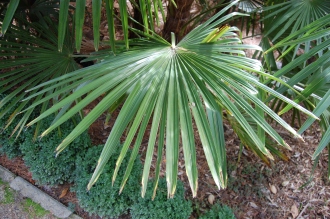Position: Full sun
Flowering period: Late summer
Soil: Moist, well drained
Eventual Height: 15m
Eventual Spread: 2m
Hardiness: 7b, 8a, 8b, 9a, 9b, 10a
Family: Arecaceae
Trachycarpus takil is an evergreen palm with an unbranched single stem. Its mid green leaves have a rounded, fan shape, have up to 60 segments, are up to 1.2m across and have a whitish underside. Its trunk is rough and covered in a fibrous mat and may become smooth when mature. Its yellow dioecious flowers appear as large pendant panicles and appear from the leaf bases. Its fruit is the size and shape of a coffee bean.
Trachycarpus takil, commonly known as Kumaon Palm, is native to the foothills of the Indian side of the Himalaya. In its native habitat it grows in mixed Oak forests.
The etymological root of the binomial name Trachycarpus is derived from the Greek trachus meaning ‘rough’, and karpus meaning ‘a fruit’, due to the fruit of some species being hairy. Takil is named after the local name for this plant and the name of the mountain on which it was found.
The landscape architect may find Trachycarpus takil useful as an attractive palm which is hardy in the UK. It looks attractive when planted as a specimen, in rows or avenues.
Ecologically, Trachycarpus takil is attractive to pollinating insects.
Trachycarpus takil prefers moist, fertile, well-drained soils. It tolerates most pH of soil.
Trachycarpus takil requires little maintenance.







